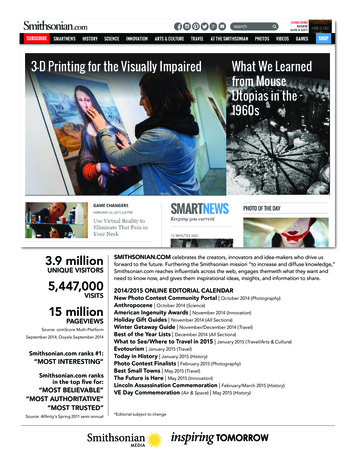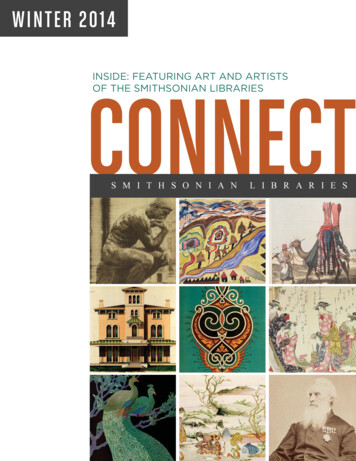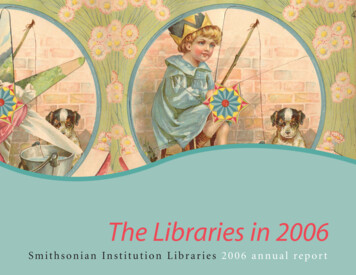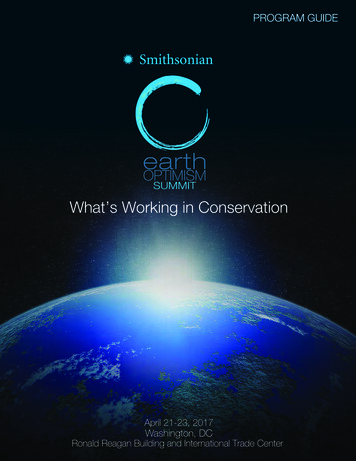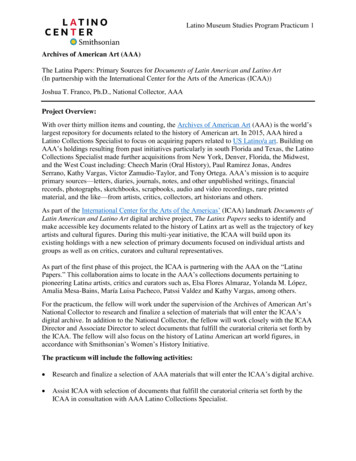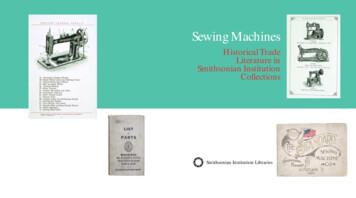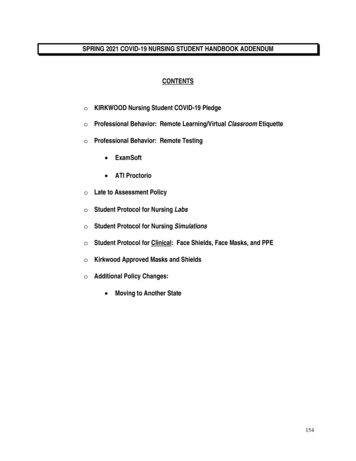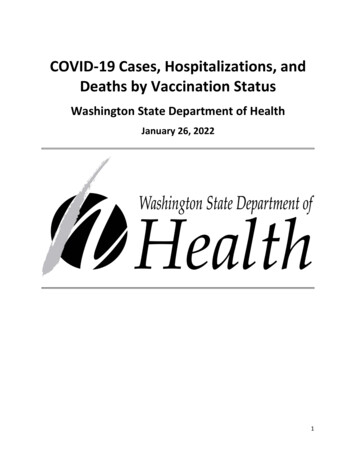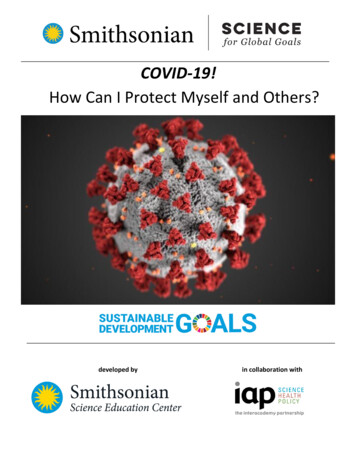
Transcription
COVID-19!How Can I Protect Myself and Others?developed byin collaboration with
Smithsonian Science for Global GoalsCopyright Notice 2020 Smithsonian InstitutionAll rights reserved. First Edition 2020.Copyright NoticeNo part of this module, or derivative works of this module, may be used or reproduced for any purpose exceptfair use without permission in writing from the Smithsonian Science Education Center.Smithsonian Science Education Center greatly appreciates the efforts of all the individuals listed below and inthe acknowledgments section in the development of COVID-19! How Can I Protect Myself and Others? Eachcontributed his or her expertise to ensure that this project is of the highest quality.Smithsonian Science Education Center Module Development StaffExecutive Director - Dr. Carol O’DonnellDivision Director of Curriculum andCommunications - Dr. Brian MandellDivision Director of Professional Services - Dr.Amy D’AmicoManager of Digital Media - Ashley DeeseProgram Manager for Leadership Developmentand International Programs - KatherineBlanchardManaging Editor - Patti MarohnScience Curriculum Developer - Andre RadloffProgram Assistant - Alexa MogckScience Curriculum Developer - Logan SchmidtCurriculum Product Specialist - HannahOsbornDigital Producer - Ryan SeymourSenior Project AdvisorsDr. Marc SprengerLisa A. Cooper, MD, MPHAnne McDonough, MDCassie Morgan, MPHShweta Bansal, PhDDr. Maryam BigdeliThe contributions of the Smithsonian Science Education Center: Module Support Staff, Technical Reviewers,and Translation Proofreaders are found in the acknowledgments section.Cover design by Ashley Deese, SSEC; Layout design by Ryan Seymour, SSEC and Ashley Deese, SSECImage CreditsCover - CDC/Alissa Eckert, MS; Dan Higgins, MAMSFigure 1.1- Katherine Blanchard, SSECFigure 1.2- Katherine Blanchard, SSECCovid-19! How Can I Protect Myself and Others?Figure 4.1- Logan Schmidt, SSECFigure 5.1- Katherine Blanchard, SSECFigure 7.1- Erin Lisette 2020 Smithsonian Institution
Dear Parents, Caregivers, and Educators,As we face COVID-19 as a global community, it can be difficult to put into words what we as adults are feelingand even more challenging to discuss these feelings with young people. As the young people in your care movethrough this guide with you, some difficult questions may come up. What is COVID-19? What is happening inthe world and how are people feeling about it? How can keeping our distance, washing our hands, and coveringour nose and mouth help protect us? How is COVID-19 impacting families and communities? How can stayinginformed about COVID-19 make a difference? What actions can I take right now to protect myself and others?You do not have to have the “answers” to any of these questions. The most important thing that you can offer toyoung people is honesty and security.The foundation of this material is in science. One of the best ways to become comfortable with the changingstate of the world is by arming yourself with knowledge and then using that knowledge to make a difference inthe world. This is true for young people as well. As youth around the globe engage with the activities in thisguide, they will gain an understanding of the science that underlies COVID-19. They will be able to share theirknowledge with their community, create tangible ways to take action in this challenging time, and understandthe best places to find additional information on the topic.But this new knowledge may also be scary and overwhelming for people who are young. They may requiresupport and guidance from you to put their new knowledge into context. Ask the young people around you howthey are feeling and what they are thinking about what they have learned. Validate the questions they ask you,even if they ask them over and over again.These tasks are designed to be completed in collaboration with the young person in your care. Each task isdriven by a question that young people may ask you about COVID-19. Each task is structured in a way to helpyoung people (and you) to: (1) Discover the answers to the question in your own environment; (2) Understandthe science that underlies the question; and then (3) provide guidance to help you and the young people you carefor Act on your new scientific knowledge.What can young people do to use their new knowledge to protect themselves and others? Task 1 should helpyou and each young person you care for understand who they are so that they are better prepared to understandothers. This is important because as you complete Tasks 2–4, you will interact with people with whom you areisolating or with your friends or families virtually. These interactions will help provide the foundationalunderstanding for Tasks 5–7 on how to protect yourself and others from COVID-19.As a parent, caregiver, or educator, you may decide to skip certain questions, activities, or an entire taskbecause doing so may go against local guidelines or may be of concern to you. This is okay! Please personalizethe interactions so that your health and safety and the health and safety of the young people in your care are ofutmost concern.At the Smithsonian Institution, we are not first responders, but we are experts in helping young people tounderstand science and how it impacts the world around them. We also deeply believe in the importance ofusing the United Nations Sustainable Development Goals (SDGs) as a framework to focus on sustainableactions that are defined and implemented by youth. As part of the Smithsonian Science for Global GoalsCovid-19! How Can I Protect Myself and Others? 2020 Smithsonian Institution
Smithsonian Science for Global Goalsproject, COVID-19! How Can I Protect Myself and Others? addresses SDG Goal 3 (Good Health and WellBeing), Goal 4 (Quality Education), Goal 6 (Clean Water and Sanitation), and Goal 11 (Sustainable Cities).We also recognize the incredible power of collaboration and working together closely with others, even at adistance. We are immensely grateful to the World Health Organization (WHO), the InterAcademy Partnership(IAP), Johns Hopkins University, and our colleagues at the Smithsonian for their perspectives and for theirtechnical support in ensuring the science is accurate. We are grateful to the Gordon and Betty MooreFoundation for their support during the development of this module. We are also grateful to WHO and IAP forproviding the translations and proofreading to ensure young people and you—as their parents, caregivers, andeducators across the globe—can interact with this content.“The Smithsonian Science Education Center makes science exciting and approachable for children and youthall over the world and encourages them to explore the how and the why of things around them. TheSmithsonian Science for Global Goals project uses an innovative methodology where children and youth learnby doing and have to discover the answers themselves. Understanding the relationship between human beingsand the environment will help us live in harmony and also prepare for future pandemics. With all the mythsand misconceptions out there, it is important for children and youth to understand the nature of this pandemicand what can be done to prevent future pandemics from happening.”- Dr. Soumya Swaminathan, ChiefScientist, World Health Organization"It is so important for children—wherever they are in the world—to develop their scientific understanding andrational thinking. Only by being able to make rational decisions based on the best science and evidence can anyof us adjust our behaviour to keep ourselves and our families safe from infections such as COVID-19."Professor Volker ter Meulen, InterAcademy Partnership PresidentCOVID-19, like any pandemic, is frightening. It has upended our lives. But it has also brought us closertogether as a global community. We may live across geographic boundaries, but we are all in this fight together.And science—and action—can help us win this battle together.Stay safe. Stay healthy. Stay informed.Best,Dr. Carol O’Donnell, DirectorSmithsonian Science Education CenterCovid-19! How Can I Protect Myself and Others? 2020 Smithsonian Institution
Smithsonian Science for Global GoalsCOVID-19! Storyline OverviewTask 1: What is happening in the world right now?.Pg 1Task 2: How can keeping distance from others help?.Pg 6Task 3: How can covering our noses and mouths helpprotect us?.Pg 10Task 4: How can washing our hands help protect us? . .Pg 13Task 5: How is COVID-19 impacting families andcommunities?.Pg 17Task 6: How can staying informed about theproblem help?.Pg 21Task 7: What actions can I take right now?.Pg 25References .Pg 29Acknowledgements .Pg 30Covid-19! How Can I Protect Myself and Others? 2020 Smithsonian Institution
Smithsonian Science for Global GoalsTask 1: What is happening in the world right now?Discover: How is life changing during COVID-19? (15-30 minutes)You may have noticed that a lot is different than it was a few months ago. The adults around you mayseem stressed or anxious. You may be feeling the same way, especially if you have watched the news, spenttime on social media, or talked to friends.This project, COVID-19! How Can I Protect Myself and Others? will help you, and your community,understand the science of the virus that causes COVID-19 and other viruses like it. It will help you to figure outhow this virus is impacting or affecting you or may impact you in the future. It will help you to understand theactions that you can take to keep yourself and your community safe.In this project, you will discuss how people feel about the virus. You will investigate the science of thisvirus. You will explore public health measures, which are things that are happening in your community or mayhappen soon to keep COVID-19 from spreading. You will take action to support health in your community.1. Start with a conversation. You can speak to a parent, caregiver, or trusted adult. Talking to a sibling, afriend, or someone you can call on the phone is great, too! You can use the following structure to helpguide your conversation.2. If you are able to, sit face-to-face with your partner. Take 30 seconds to think about this question: Howhas life changed recently and how do I feel about it?3. Choose a speaker and a listener. For the next 2 minutes, the speaker gets to respond freely to thisquestion. The listener’s job is to actively listen, but not say anything. Once the 2 minutes are finished,switch roles.4. Repeat the same conversation model for the following three questions:a. Do I understand why this is happening?b. What are my fears about COVID-19?c. What am I excited about?5. Once you have finished the conversation, thank your partner. Discuss anything that came up that youmight like to talk more deeply about. This conversation structure is called a Dyad. It is a way to talkabout challenging things so that all feel heard and respected.1 Emotional Safety: Was this conversation scary? Was it sad? Was it helpful? Youwill see this note when these feelings might come up. This is a good time to checkin with a trusted adult or a friend.6. During this project, you will be asked to collect your thoughts, feelings, and research. It is up to youhow you choose to record it. Just keep the information safe. So that it does not get confusing, we willcall it a “journal” for the rest of the project. There are a few different reasons to do this2:a. There is a lot happening in the world! One of the best ways to process how you are feeling is towrite it down.b. Scientists keep records! Throughout their research, scientists capture data about what they arestudying so that it is all in one place.Covid-19! How Can I Protect Myself and Others? 2020 Smithsonian Institution
Smithsonian Science for Global Goalsc. You are experiencing history! It may not feel like it right now, but the world is experiencing amajor historical event. History is preserved on a global and state level. But you are also a part ofit. Someday future generations will want to know what it was like to be here now.7. Take some time to record how you are feeling about COVID-19 in your journal. What has yourexperience been so far? What did you learn from your Dyad conversations?Understand: How would I describe myself? (30 minutes)1. It’s time to create your identity map! An identity map is a graphic tool that can help people tounderstand the things that shape them as an individual. You can do this with others or by yourself. Youcan write down your identity map in your journal.2. Start with your name in the center.3. Put a circle around your name.4. Answer the question, “Who am I?” or “What describes me?” You can use the following list of categoriesto help, but do not feel limited to only the things on this list.AgeSchool/ClassRace or EthnicityGenderNationalityReligionFamily background/originInterests, hobbies, or things youlike to do for funPhysical traits (tall, black hair, blueeyes, wears glasses)Personality traits (loud, funny, sad,kind)Role in family (sister, son, cousin)Anything else you can think of!5. If you want, you can use objects around your home to create your map. To preserve your map, you cantake a picture or capture it in a memory.6. A young girl named Ada created two versions of her identity map for you to see:Figure 1.1 This is an example identity map.Covid-19! How Can I Protect Myself and Others?She will add these things to her map at the end ofeach line:a. Big sisterb. Loves elephantsc. Wants to travel to a big cityd. Loves sweetse. Listens to lots of musicf. Learning to sewg. Best friend is Ninah. In grade 7 (primary school)i. Spends lots of time in naturej. Favorite colors are orange and green 2020 Smithsonian Institution
Figure 1.2 Ada made an identity map with objectsfrom around her home. Here they are displayed.7. Ada’s physical identity map includes thesethings (along with a flag from her country):a. Puzzle piece because her littlebrother loves puzzlesb. Model elephant, which is her favoriteanimalc. Postcard from a big city because shewants to travel thered. Fruit because she loves sweetse. Headphones because she listens tolots of musicf. Needle and thread because she islearning to sewg. Bracelet from her best friend Ninah. “7” card because she is in grade 7i. Leaf because she spends lots of timein naturej. Orange and green pencil for herfavorite colors8. What have you included in your identity map? Put them in your journal, or capture it in a memory. Ifyou are doing this activity with someone else, you can discuss your identity maps together. Here arequestions to guide your thinking:a. How might your identity map change over time?b. How much control do you have over the things on your identity map?c. How might things on your identity map affect decisions you make in life?9. Now think about how the things on your identity map affect your life.10. Turn your attention back to COVID-19. It’s time to make a map of what you know and what you wouldlike to learn about COVID-19.11. In your journal, find a new space and write “COVID-19” in the center. Circle it.12. Write down what you know or think you know about COVID-19. Here are things that may help guideyour thinking:What is it?Can you see, taste, or touch it?How do people get it? Are some people morelikely to get it than others?Are there things you can do to protect yourselffrom getting it?What is it doing to your community?What is it doing to the world?13. You don’t need to have all of the answers right now. If there are questions you have about COVID-19,write them down. Throughout the project, you may be able to answer some of these questions. You mayhave more questions to add to your map. You can refer back to these questions at the end of each task.Covid-19! How Can I Protect Myself and Others? 2020 Smithsonian Institution
Smithsonian Science for Global GoalsAct: What are things we can do to feel safe? (30-45 minutes)1. COVID-19 is scary for everyone. But there are some things you can do to help you to feel safe:a. Are there things that you do in your home that make you feel more safe? Make a list of thesethings in your journal.b. Speak with others in your home about continuing these practices. Physical Safety: Talk to an adult to make sure these things are in line with local safetyguidelines.2. Another strategy that you can practice any time you feel anxious, nervous, or scared is breathing. Trythis:a. If it is comfortable for you, start by closing your eyes.b. Notice what you hear and what you smell in the space around you.c. Place your hands on your stomach, just below your belly button.d. Inhale through your nose. Fill your belly with air so it presses against your hands.e. Exhale out your mouth, pushing out all of the air that was in your belly.f. Do this four more times or as many times as you need to feel more calm and secure.3Remember that no matter what is happening, you are not alone. Scientists, researchers, and healthcareworkers all over the world are working on finding solutions to COVID-19. They are working to keepeveryone safe. You will see quotes from some of them throughout this project. Before you go on to thenext task, here are some COVID-19 basic facts to help you get started.3. What is COVID-19?a. COVID-19 is a disease. It is caused by a virus called SARS-CoV-2. Scientists think this virusfirst spread from an animal to a person. Scientists now know that it can spread from one personto another person.4 Scientists are trying to find out more about if this virus can spread frompeople back to animals.b. SARS-CoV-2 virus is part of a family of viruses called “coronaviruses.” The illustration on thecover of this module is of a coronavirus. They are called this because the pointy structuresemerging from the viruses look like a crown or a “corona” when scientists look at them under amicroscope.5c. COVID-19 is difficult to track or trace because it takes between 1 and 14 days for people tobegin feeling sick, or “showing symptoms.”d. A symptom is what people feel when they are sick. Symptoms of COVID-19 may include: fever,dry cough, tiredness, body aches, and shortness of breath or difficulty breathing. Some peoplemay also lose their sense of smell or sense of taste. A stuffy nose or sore throat have been rare.e. Some people who get COVID-19 become very ill and find it difficult to breathe. Older peopleand those with other medical conditions have more chance of becoming very ill, though this canhappen to anyone.f. Some people who are carrying the virus in their bodies will never show any symptoms or looksick. But they can still pass the disease to others. This is called being “asymptomatic.”6g. This virus is affecting the health of people all over the world. It is also changing how peopleinteract with each other, how they do business, their impact on Earth, and what they feel is rightand wrong. You can learn more about these social, economic, cultural, environmental, andethical perspectives throughout the project. Look for information from experts and in theactivities.Covid-19! How Can I Protect Myself and Others? 2020 Smithsonian Institution
Smithsonian Science for Global Goals4. This disease is evolving. For the most up-to-date information, please see the additional resource sectionsbelow.5. One thing you can do to feel safer from COVID-19 is to learn more about it. The more you understand,the less scary it becomes. The more you understand, the better you can protect yourself.“There are always two pandemics. The first and most obvious is the worldwide spread of a pathogen - virus,bacteria, etc. The second causes just as much damage but is not always recognized or named. It’s fear.Sometimes fear will just waste time and resources as people try to do something. Watch and see if thereactions in people around you and in yourself are based on fears or on facts. You must always address thefear first if you ever want anyone to listen and act on the facts.” - Anne McDonough, MD, MPH, PublicHealth Emergency Officer, Smithsonian Occupational Health Services, United States of America (USA)6. In the rest of this project, you will learn about many aspects of COVID-19. In some cases, you will learndirectly from scientists and researchers working around the world. You will see quotes from themthroughout this project. You will find answers to many of the questions that you thought of earlier andhopefully you will feel safer!Additional Resources:World Health Organization Q&A on coronaviruses (COVID-19): An overview of COVID-19, its symptoms,and how to protect q-a-coronavirusesEmerging respiratory viruses, including COVID-19: methods for detection, prevention, response and control:Video overview of COVID-19 and other tion-to-ncovCovid-19! How Can I Protect Myself and Others? 2020 Smithsonian Institution
Smithsonian Science for Global GoalsTask 2: How can keeping distance from others help?Discover: Do you notice people keeping distance from others? (15-30minutes).1. Think about the following questions. Write your own thoughts in your journal.a. Have you heard people talking in your home or community to keep more distance from eachother than before? Why do you think this is happening?b. Are there physical distancing orders from local leaders or authorities where you live? How doyou feel about that?c. If there are not currently orders to stay home where you live, answer this question. How wouldyou feel if the government ordered you to stay home and not leave for weeks or months?2. Interview each of the people in your home using the following questions. Write your notes in yourjournal.a. Are you keeping distance from other people right now? Why or why not?b. Have you come into contact with any sick people recently? If so, when and where?c. Do you think all of the people in our home should keep distance from people outside our home?Why or why not? Learning Tip: When you conduct a survey, ask everyone the same questions. Record your answers inthe same way every time. Keep all of your answers together so you can look for trends in them later! Emotional Safety: Sometimes people do not like to talk about their personalhabits. That’s okay! You can skip a question. Or just ask the last question aboutwhat they think we should do?Understand: Why is distance so important? (45 minutes)1. Think about the social perspectives of the problem in your community as you read the following quotefrom an expert.“COVID is spread through respiratory droplets. These droplets travel from one person to another, includingfrom our hands. Think of a typical day in your community. You greet multiple people with handshakes, hugs,and kisses. You buy things at the store using money that has passed from person to person. You areconstantly interacting closely with people and things. These are all opportunities to spread COVID. Limitingthese interactions and contacts is what reduces community transmission.” - Cassie Morgan, KuunikaSustainability Coordinator, Cooper Smith, MalawiCovid-19! How Can I Protect Myself and Others? 2020 Smithsonian Institution
Smithsonian Science for Global Goals2. To understand why distance is so important you must understand three other things about COVID-19:respiratory droplets, being asymptomatic, and contact? Try this activity:a. Blow a long slow breath into a dry cup or onto a mirror. Observe and feel the inside of the cup ormirror.b. Do you notice that it feels wet? This is one example of respiratory droplets.3. Read the following to learn more:Respiratory droplets are very small drops of fluid that come from the lungs, nose, and mouth. When aperson coughs, sneezes, or talks, the droplets can come out of the body. These droplets come out of the bodythrough saliva and mucus. Respiratory drops mostly consist of water. All people, not just those who are ill,produce respiratory droplets.Respiratory droplets can be of many different sizes. Sneezing and coughing can produce larger droplets.These droplets can spread COVID-19 if a person is infected with the virus. When healthy people come intocontact with respiratory droplets from a person with COVID-19, the virus could be spread to them.Some people who are carrying the virus in their bodies will never show any symptoms or look sick. But theycan still pass the disease to others.6 This is called being “asymptomatic.”6Being asymptomatic means you can still spread the virus to other people in the same ways as people whofeel ill. This happens through the spread and contact with respiratory droplets.There are different types of contact that can spread the respiratory droplets between people.a. Direct Contact - Any person who is in close contact (within 2 meters) with someone who hasrespiratory symptoms (coughing). The risk is directly exposing your mouth, nose, or eyes to therespiratory droplets from the ill person. In these situations, you are more likely to breathe in theviruses when an ill person coughs, sneezes, or speaks.b. Indirect Contact - Respiratory droplets containing the virus from a cough, sneeze, or talkingmay land on an object like your hand, a table, doorknob, or handrail. The COVID-19 virus couldremain there for some time. Sometimes from a few hours to several days. Another person could thentouch the object with their hand. If that person touches his or her face, mouth, nose or eyes, the virusgets into their body.Understanding how respiratory droplets move is an important part of COVID-19 spread. Remember that theCOVID-19 virus can be spread from person to person through these droplets. Physical Safety: Safety is always important when studying diseases like COVID-19. In these cases,it is better to use and study a model than the real thing. As you learned earlier, respiratory dropletsmostly consist of water. So instead of studying respiratory droplets from real coughs and sneezes,you will study a model of them using water.4. Now you will create a model of respiratory droplets. This water model will help you observe how fardroplets of water can move. These observations may help you think about how far you should stay fromothers when they cough, sneeze, and talk.You will need these materials: Bowl or cup with enough water to cup in your hand, cloth to clean upwater on hands and surfaces, measuring device (ruler or use your foot), objects or tape to mark offdistances from the wall.Covid-19! How Can I Protect Myself and Others? 2020 Smithsonian Institution
Smithsonian Science for Global Goals Physical Safety: Please ask an adult or older person in your home to help you. Before starting thisexperiment, you should wash your hands for 40 seconds with soap and water.5. Locate an open area with a wall inside or outside of your home. Make sure you have permission to get ita little wet, such as a bathroom or outside wall. Location requirements:a. You need to be able to stand very close to the wall.b. You need to also be able to stand at least 2 meters (4-6 steps) or more away from the wallwithout anything in your way.6. Using your measuring device, mark off the following distances from the wall on the floor:0.5 m, 1.0 m, 1.5 m, 2.0 m, or just count steps (1 step from wall, 2 steps, 3 steps, 4 steps).7. Stand facing the wall at the 0.5 m or 1 step mark with a bowl of water.8. You will now model respiratory droplets leaving your mouth and nose from a cough or sneeze byflicking water from your hand toward the wall. To do so:a. Hold the bowl of water with one hand below your chin to prevent dripping.b. Dip your other hand into the water to get all of your fingers wet.c. Shape your hand into a fist. Quickly lift your fist out of the water over the bowl.d. Quickly flick just your fingers 2-3 times toward the wall. Some of the water should fly off ofyour hand toward the wall. If it does not, practice and adjust until you find a method that worksfor you.9. Look closely at the pattern of droplets on the wall and floor in front of you. Make a drawing and recordyour observations in your journal.a. Are all the droplets the same size?b. How high up the wall were the highest and lowest droplets?c. How close together are the droplets?d. Were there more droplets on the floor or wall?10. Use your cloth to clean and dry the wall and floor.11. Repeat the experiment at 1.0 m (2 steps), 1.5 m (3 steps), and 2.0 m (4 steps) distances from the wall.Clean and dry the wall and floor between each trial.12. Compare and contrast your observations at the different distances. Make a chart in your journal tocompare your data for each distance.13. If water droplets still make it to the wall at the 2 m (4 step) distance then try this: Continue movingfarther away from the wall at 0.5 m (1 step) increments to see how far away you need to be until nodroplets make it to the wall.a. What is the farthest you could flick droplets to the wall?b. Write your observations in your journal.14. Remember, the water is simulating potentially infected droplets that leave the body when you cough,sneeze, talk, or breathe. Considering your observations of this model, why is distance an importantfactor to think about when protecting yourself and others? Write your ideas in your journal.Act: What can you do or share about physical distancing? (15-30 minutes)1. Think about the economic, cultural and social perspectives of the problem as you read the followingquotes from experts.Covid-19! How Can I Protect Myself and Others? 2020 Smithsonian Institution
Smithsonian Science for Global Goals“Economics is the big picture of what groups of people do to survi
Digital Producer - Ryan Seymour Senior Project Advisors Dr. Marc Sprenger Lisa A. Cooper, MD, MPH . Smithsonian Science for Global Goals project uses an innovative methodology where children and youth learn by doing and have to discover the answers themse
